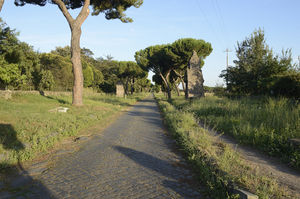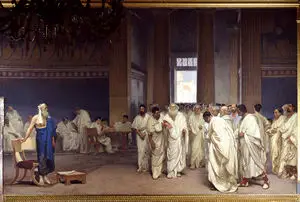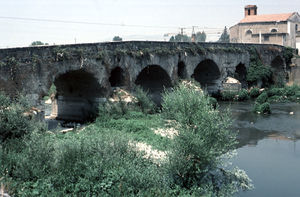Difference between revisions of "What Was the Importance of the Appian Way during the Roman Republic"
(Created page with "300px|thumbnail|left|The Appian Way Most people are familiar with the expression “all roads lead to Rome,” but few know that the Roman road known...") |
(No difference)
|
Revision as of 21:47, 11 January 2018
Most people are familiar with the expression “all roads lead to Rome,” but few know that the Roman road known as the Via Appia, or Appian Way, was known by the Romans as the “Queen of Roads.” The Appian Way was not the first road built in Italy, but it was the first in the series of roads that connected the capital city to its vast empire and which can still be seen today in its original form in many parts of the country. An examination of the Appian Way reveals that it played an extremely important role throughout the history of the Roman Republic (509-27 BC). On a logistical level, it connected Rome at an early time with cities and regions in southern Italy, thereby bringing those places under Rome’s political hegemony. The Appian Way also helped to facilitate trade between the south and north and was used extensively in times of war.
Contents
Appius Claudius Caecus
The idea of roads was not a new concept in the world or even Italy when the Appian Way was built in the fourth century BC. The Etruscans are credited with building the first roads in northern Italy, [1] but those roads were inferior to the later Roman versions because they did not use concrete. By the time the Roman Republic began expanding outside of central Italy in late fourth century BC, the city’s prominent leaders knew that a network of permanent roads that could withstand the elements was needed. They endeavored to build a network of stone and concrete roads that would all lead to Rome with the Appian Way being the first, which is how it earned the moniker “Queen of the Roads.” The Appian Way was also the only Roman road to be named after the praenomen or personal name of a Roman. [2]
The Appian Way’s namesake was a remarkable man who was ambitious and multi-talented in the tradition of Aristotle and other great classical thinkers. Appius, whose full name was Appius Claudius Caecus (ca. 340-273 BC), was a patrician of Sabine descent and a member of the famous Claudii family that spawned the Julio-Claudian Dynasty nearly 300 years later. [3] Although Appius was born into privilege, he never rested on his laurels and instead spent most of his life improving himself and the Roman people.
Appius’ career spanned several decades and covered a wide range of different positions. As a scholar, Appius translated Greek classics into Latin and as a warrior he defeated the Samnite, Sabine, and Etruscan armies, thereby enlarging Roman territory. Once those armies were destroyed, Appius knew that it was only a matter of time before Rome’s population would explode so he helped devise eleven aqueducts that brought water into the city. [4] In addition to these achievements, Appius held several important government titles throughout his life including the following: censor, consul (twice), dictator, questor, curle aedile (twice), interrex (three times), and tribunus militum (three times). [5]
The Creation of the Road
While Appius was still a relatively young man and holding the important title of censor, he came up with the idea of a road that would connect Rome to its new colonies in the south. When construction began on the Appian Way in 312 BC, Appius, as well as other leading men in the Roman Republic, saw it as a economic and political boon for their city. Essentially, Appius saw the road as a way to change Rome’s agrarian based economy to one in which commerce played a bigger role. [6] The Romans particularly coveted the fertile lands just to the south of Rome around the city of Capua. The first century BC Greek geographer, Strabo, noted that the region was a prime location for wine production:
“The Caecuban Plain borders on the Gulf of Caietas; and next to the plain comes Fundi, situated on the Appian Way. All these places produce exceedingly good wine.” [7]
Bringing more wine and other agricultural commodities quicker and easier to Rome was certainly one of the reasons why the Appian Way was built, but political considerations were an equally important factor in its creation.
The area to the south of Rome, known as Campania, was as influential politically as it was economically. Many Roman senators owned villas in the region and Campania’s leading citizens were quickly acquiring Roman citizenship and learning how to yield that power in the often Machiavellian precincts of the Forum. The first leg of the Appian Way, completed in 312 BC, connected Rome to this new group of elites who were based in the city of Capua. Not long after Rome and Capua were connected by the Appian Way, the first Roman coins were produced, which many modern scholars believe was no coincidence. [8]
By the time the Appian Way was completed in the early third century BC, it stretched from Rome in the north to Brundisium in the far south of Italy in the heel of the country. The Emperor Trajan (ruled AD 53-117) later added an alternative route that diverged from the original road in Beneventum, passing through south-central Italy before reconnecting with the Appian Way in Brundisium. In total, the road stretched about 350 miles and for most of Roman history was well maintained. Engineers made sure that damaged sections were repaired and a number of way stations and inns could be found every few miles for weary travelers. [9] The Appian Way was perhaps the best known and most traveled of all the Roman Vias, but it not only helped facilitate trade and political machinations – several great armies marched on its cement surface.
Some Notable Events on the Appian Way
After it was built, the Appian Way was the scene of many major historical events well into the modern period. During the Republic, most of the events were battles and wars, the first of which was the Pyrrhic War (280-275 BC). The Pyrrhic War was fought between Rome and the Greek kingdom of Epirus, led by King Pyrrhus (318-272 BC), over control of the southeastern Italian coastal city of Tarentum. The Romans wished to incorporate Tarentum into their growing republic, but Epirus resisted its efforts based on the argument that the city was originally founded by Greek colonists. Pyrrhus won most of the early battles in the war, although at great cost to his army – hence the modern term “Pyrrhic Victory” – and 275 BC the Greek king appeared ready to march on Rome with his large army that included a number of elephant troops. Instead, the Romans used the Appian Way to transport their army quickly to Beneventum, where they met the Greeks on the famous road.
“Pyrrhus, however, divided his army into two parts, sent one of them into Lucania to attack the other consul, that he might not come to the help of his colleague, and led the other part himself against Manius Curius, who was safely encamped near the city of Beneventum and was awaiting assistance from Lucania; in part also it was because his soothsayers had dissuaded him with unfavourable omens and sacrifices that he kept quiet. . . . Down they came from their strong places, and hurling their javelins at the elephants compelled them to wheel about and run back through the ranks of their own men, thus causing disorder and confusion there. This gave the victory to the Romans, and at the same time the advantage also in the struggle for supremacy.” [10]
After defeating Pyrrhus in the Pyrrhic War, the Romans learned that the Appian Way could play a crucial role in their national defense. It allowed them to quickly move their troops from the capital city in order to meet any invading armies in the south. About sixty years later, the Romans also learned that the Appian Way could be used against them. The Second Punic War (218-202 BC) was a struggle for supremacy in the western Mediterranean region between Rome and Carthage and although the Romans eventually won the war, for most of the war the outcome was in doubt. The reason that Rome almost lost the Second Punic War was because the Carthaginians were led by the very able and intelligent commander, Hannibal Barca (ca. 247-181 BC). Part of Hannibal’s strategy was to starve Rome by occupying the agriculturally rich areas of southern Italy and forcing its inhabitants to pledge fealty to him. One of the early engagements between Hannibal and the Romans took place in 217 BC near the city of Tarracina, which was about halfway between Rome and Capua. In that engagement, the Roman generals Minucius and Fabius attempted to protect the Appian Way from the Carthaginian general, but were severely routed. With the Appian Way clear, Hannibal was free to march further south and destroy Cannae in 216 BC. [11] Hannibal spent most of the remainder of the war moving his troops up and down the Appian Way, threatening Rome, and did not leave Italy until Scipio took a page out of his own playbook by invading Carthaginian territory.
The next major round of bloodshed to take place on the Appian Way was the Third Servile War (73-71 BC), which is sometimes known as the “Spartacus Uprising.” In that war, Spartacus led an army of former slaves that grew to as many as 40,000 by 72 BC. Many of Spartacus’ army’s movements and battles were fought along the Appian Way and the road was also the scene of the war’s final resolution when 6,000 rebels were crucified alongside both sides of the road. [12]
Conclusion
The Appian Way was called the “Queen of Roads” by the Romans for a number of reasons. Besides being the first in their well-made and intricate series of Vias that connected the provinces to Rome, it provided economic and political benefits to both Rome and southern Italy. Eventually, the Appian Way helped integrate southern Italy more thoroughly into the Republic, helping make the people of the region full-fledged Roman citizens. The Appian Way was also important because it was the scene of some of the Roman Republic’s most important wars. The Romans fought for their very survival along the Appian Way and learned how it could be used to both their benefit and detriment. Truly, the Appian Way was perhaps the most important road in Roman history, especially during the Republican period.
References
- ↑ Sitwell, N.H.H. Roman Roads of Europe. (New York: Saint Martin’s Press, 1981), p. 16
- ↑ MacBain, Bruce. “Appius Claudius Caecus and the Via Appia.” Classical Quarterly. 30 (1980) p. 361
- ↑ Hamblin, Dora Jane, and Mary Jane Grunsfeld. The Appian Way: A Journey. (New York: Random House, 1974), p. 13
- ↑ Hamblin and Grunsfeld, pgs. 21-30
- ↑ Stavely, E. Stuart. “The Political Aims of Appius Claudius Caecus.” Historia: Zeitschrift für Alte Geschichte. 8 (1959) p. 410
- ↑ Stavely, p. 419
- ↑ Strabo. Geography. Translated by Horace Leonard Jones. (Cambridge, Massachusetts: Harvard University Press, 2001), Book V, 3.6
- ↑ Crawford, Michael. “Early Rome and Italy.” In The Oxford History of the Roman World. Edited by John Boardman, Jasper Griffin, and Oswyn Murray. (Oxford, Oxford University Press, 2001), p. 32
- ↑ Hamblin and Grunsfeld, p. 55
- ↑ Plutarch. Lives. Translated by Bernadotte Perrin. (Cambridge, Massachusetts: Harvard University Press, 1968), Pyrrhus, XXV
- ↑ Livy. The History of Rome. Translated by D. Spillan and Cyrus Edmonds. (London: George Bell and Sons, 1909), Book XXII, 15-16
- ↑ Kohn, George C. Dictionary of Wars. (New York: Facts on File Publicantions, 1986), p. 416



